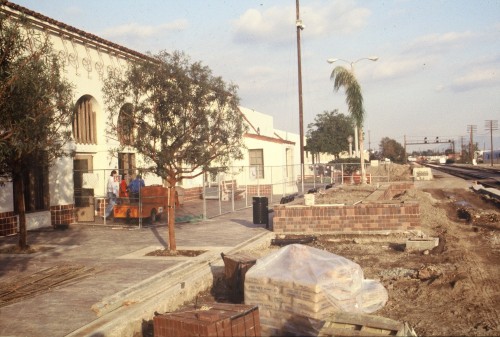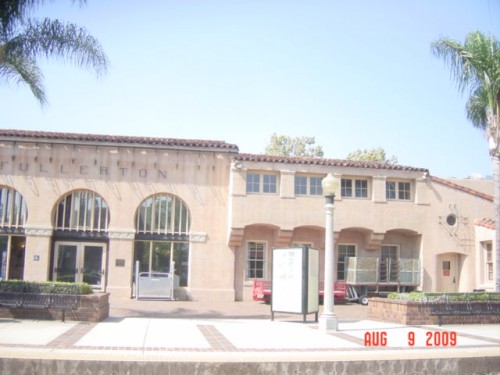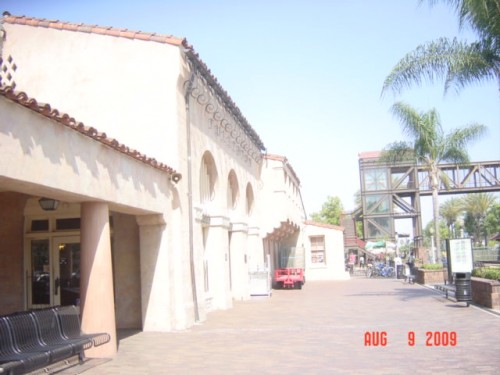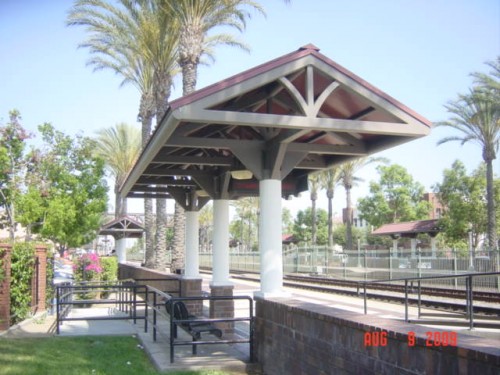The North Platform Fiasco – Allegro Molto e Vivace
Loyal and Patient Friends, our sad narrative of The Great North Platform Disaster now draws to a merciful conclusion. We have shared all the dismal failures of the landscape architect, Steve Rose, the Redevelopment manager in charge, Terry Galvin, and Design Review Committee members that were evidently incompetent or unqualified.

The design failure was complete and palpable. Yet as diverse groups of citizens displayed their unhappiness with the ludicrous and costly elements of the project, the City Staff dug in their heels in a rear guard action to deflect blame by ignoring the obvious and fighting to keep the mess they had created. Newly minted City Manager Jim Armstrong led the effort to defend the indefensible. He went so far as to accuse one of the leading critics of the design mess of “making the City look like shit.”

The City Council, to its credit, would have none of it. They ordered construction halted. Even the Fullerton Observer demanded to know who was in charge. In what may have been the last show of independence by a Fullerton City Council, the majority demanded that the incongruous and useless elements be removed. The lone dissenting vote was that of Molly McClanahan, the eternal staff suck-up, who as Mayor tried backdoor sabotage with the State – which was also providing funding for the project. City staff was going into attack mode behind the scenes.

In the end the Council (with the sole exception of Chris Norby) lost its collective nerve and settled on a partial removal of the worst offending aspects of the project. The huge planter was split into pieces, allowing platform access through the middle.

The miserable trees were completely removed.

The canopies were salvaged though the construction of alcoves cut out of the still useless block bulkhead wall.

The wretched benches and comical little trash cylinders remain to this day. Go to the depot. You can check it out for yourselves.
It was never disclosed whether Steve Rose was back-charged for the cost of all the changes that had to be made, or whether he actually billed the City for remedial design work. Thousands upon thousands of dollars were wasted on building useless construction and then having to remove it. And what happened to the parties responsible for this complete fiasco? You mean you can’t guess by now?

Nothing, of course. The proponents of sensible and functional design were blamed by staff for making the City look bad; the whistle blowers were turned into the villains of the melodrama. Chalk up another big win for the escape artists at the Fullerton Redevelopment Agency.
U guys really are going a long way back with this. Just as “no good deed goes unpunished”, in gov’t “no fiasco goes unrewarded.”
Just look today in the Register at Brian Speegle’s cushy pension after running the OC Planning Dept. into the ground.
BTW: Trees are great, but there hasta be a balance. Jacarandas are great–on Jacaranda Ave., but they don’t belong covering up someone’s business, or in the middle of a railroad platform.
Thanks for this series. Another great expose on Fullerton’s Redevelopment Circus. True the Harpoon did go a ways back and it really is too bad blogging didn’t exist in 1993.
This history is very relevant. Check out the “Union Pacific Park” diasters of the past few years. One embarrassingly stupid or incompetent decision after another – and not a dime’s worth of accountability for those (ir)responsible. Millions wasted. For what?
This story is just stunning. Good thing it was documented for all posterity. What really bothers me about the ludicrous design choices was the “off the shelf” qualities of the elements. Everything there looks like it came out of catalogue.
Does anyone know how old the concrete and wood bench were? Were they really just thrown away? And what about the paint job on the place?
Matt, the “paint job” on the Santa Fe Depot is a whole separate story – not related to the platfrom – and will be the subject of yet another Redevelopment Follies series. I think we will throw in the little mini-saga of the Depot breezeway ceiling since that episode of incompetence and deceit actually put the public at risk, although that, too deserves its own post (or two).
Your observation about the character of the design choices is extremely apt. There is a reason for the “off the shelf” quality. I think it has to do with the fact that Redevelopment agencies by nature are both tasteless and cautious; and being government agencies they always follow the current design mainstream taste. The consequence of this is that redevelopment projects become immediate aesthetic time capsules for the era in which they are built and are quickly obsolete.
This built-in obsolescence is great for staff because they can redevelop it later as its obsolescence enters the blight zone. With no accountability and a complete disregard for wasting public funds its like hog heaven.
Why do you call the area behind the barricade “no mans land”? That’s where I sleep!
why would you sleep there? thats where i go to the bathroom
I call it no man’s land because when it was first built there was no way to get into it – and yet they planned on putting landscape plantings and irrigation in there! And they forgot, seemingly, that somebody was going to have to back in there to trim the existing hedges that grow in the fence that was already there!
That would be a pretty nasty place to sleep although I guess I can see a scatalogical function there in a pinch.
Matt, thanks to several members of the community who cared enough to protest the idea of giving the benches to the city of Perris, several of the benches stayed at the Depot. They are located on the north side of the building. The design for the bench’s were on the original plans, I assume they were a built by the contractor who built the Depot in 1929.
As far as the paint job, I believe sometime in the 60’s the building was painted. The paint was removed in 1994 to expose the original polychromatic plaster, which is another story for another day.
Was there something wrong with the old benches? Were they somehow unsafe or difficult to maintain? What possible reason could there be for removing historical furnishings from a structure with landmark status?
Matt, you can ask Terry Galvin, the man responsible. I think he’s now the president of the heritage group!